- The 2025 Mercedes-Benz AMG GT 63 S E Performance puts power above all else
- The plug-in hybrid has 805 hp and 1,047 lb-ft, but it’s heavy
- Pricing hasn’t been released, but expect a bill for over $200,000 when it comes time to pay
Between two farms outside of Mercedes’ proving grounds in Immendingen, Germany, I pull the 2025 Mercedes-Benz AMG GT 63 S E Performance to the side of an open country road. With my foot on the brake, I turn the steering wheel dial to Race mode, then floor it. The 12.3-inch digital instrument cluster flashes “Race Start Ready,” and I let go of the brake.
Zing! The V-8 engine and electric motor come together to deliver immediate, thunderous power. The Michelin Pilot Sport S 5 tires hook up at all four corners, my back cracks as my body snaps back into the supportive and well-formed sport seat, and the car rockets forward in what feels a lot like the 2.7 seconds Mercedes quotes for its performance plug-in hybrid.
I’ve just experienced the quickest Mercedes ever, enabled by a seamless blend of gas and electric power.
However, the meandering route from AMG headquarters in Affalterbach to Lake Konstanz that Mercedes has chosen for the bulk of the media drive is also telling. The route features short spurts of Autobahn, very few tight turns, and softly winding country roads. This might be the most powerful car in the brand’s most expensive sports car range, but Mercedes bakes in no track time or long stretches of mountain roads, likely because the car is simply too heavy.
The new coupe’s plug-in hybrid system adds about 500 pounds to a car that has gained 600 pounds in its second generation. It turns the GT from a sports car to a grand tourer, albeit a monstrously powerful one. Still grand, but not track sharp.
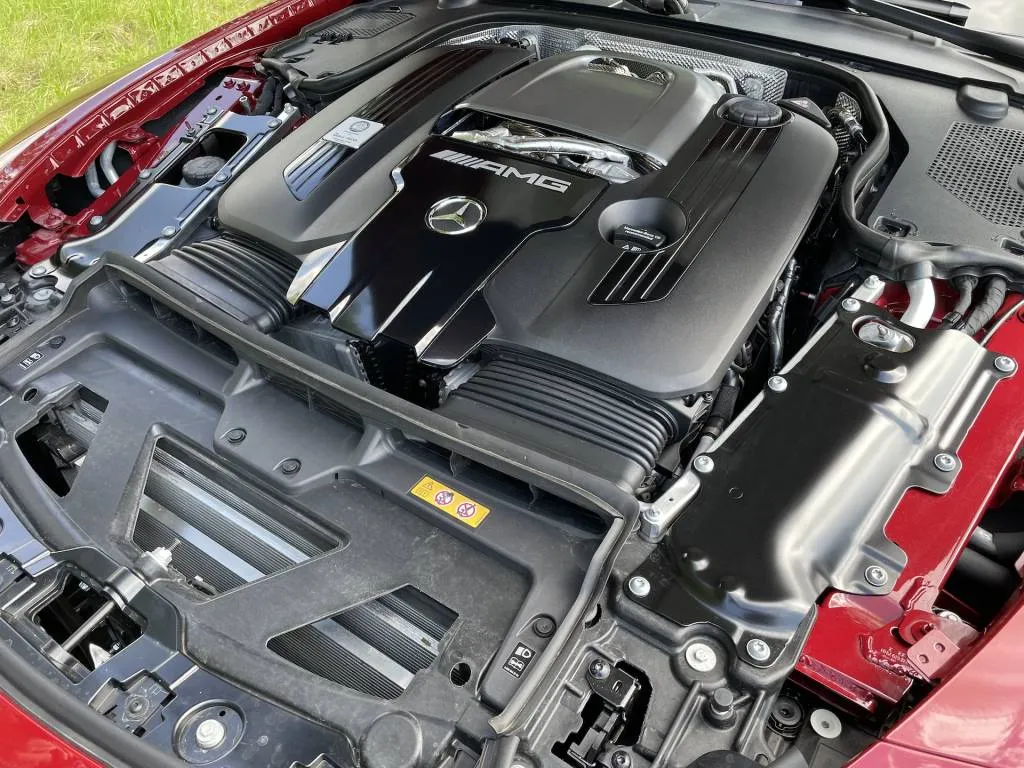
2025 Mercedes-Benz AMG GT 63 S E Performance
Mercedes AMG GT 63 S E Performance: Power abounds
The plug-in hybrid system is a technological marvel that also powers the S-Class and AMG GT 4-Door Coupe. It pairs the brand’s familiar twin-turbo 4.0-liter V-8 with a rear-mounted permanently excited synchronous electric motor. The engine spins out 603 hp from 5,750-6,750 rpm and 627 lb-ft of torque from 2,500-4,500 rpm. The motor makes 201 hp and 236 lb-ft. Combined, the engine and motor produce an incredible 805 hp and 1,047 lb-ft.
Mercedes blends the two propulsion systems well. Acceleration is predictable based on pedal position, with no awkward handoffs of power from one system to the other. The familiar guttural growl of the Mercedes V-8 accompanies the power, but so does another sound: the eerie synthetic whirr of the rear motor. At full tilt, it sounds like a spaceship landing in a pitched World War II mortar battle.
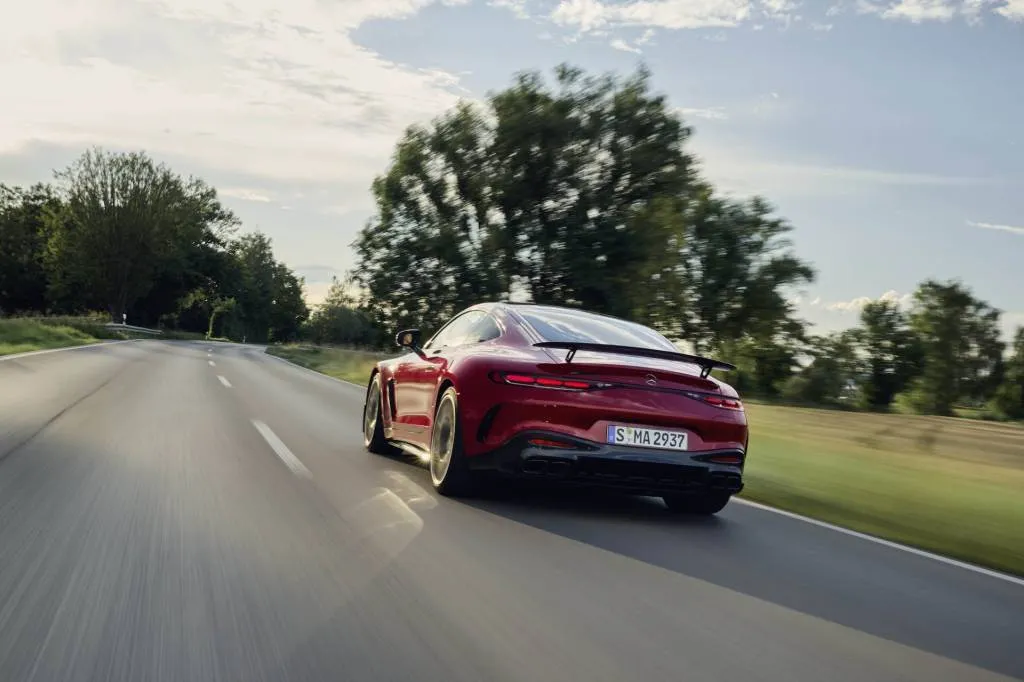
2025 Mercedes-Benz AMG GT 63 S E Performance
A couple of Autobahn blasts also show that power stays on boil at high speeds. I wait for traffic to clear then step deep into the throttle. The numbers tick by quickly: 200, 220, 240, 250, 260…263 km/h. My exit is coming up quickly, so I have to let off, but that’s 163 mph with a rock steady feel and plenty more left in the chamber. Another journalist hits 192 mph (which I find overly brave), and this car can top out at 199 mph.
The plug-in hybrid system is located on the rear axle in a rather complex arrangement shared with other performance hardware. While the engine’s power flows through a 9-speed AMG Speedshift MCT transmission with a wet clutch, the rear motor’s power goes through an integrated 2-speed transmission and a limited-slip differential. The rear transmission can spin up to 12,500 rpm before it changes gears, which can happen anywhere from 43-87 mph.
While the engine can power the front wheels, so can the rear motor as both power sources turn the driveshaft in the same direction. From there, the center differential determines how much power goes to the front.
A 6.1-kwh (4.8-kwh usable) battery is also located above the rear axle to power the motor, and the whole rear end assembly is further complicated with the addition of a rear-wheel-steering system.
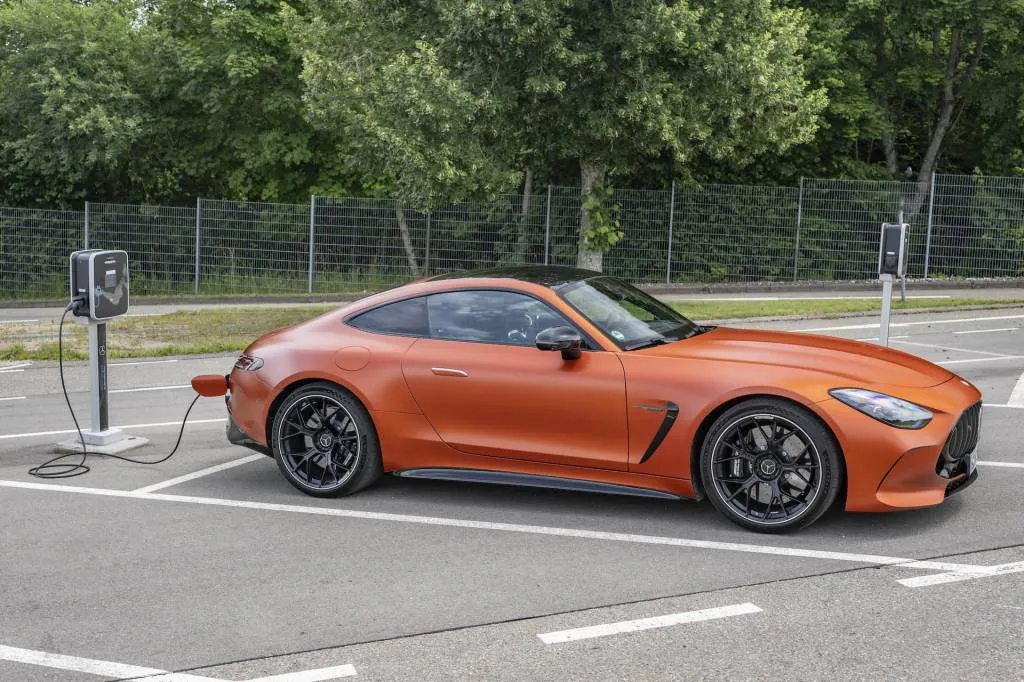
2025 Mercedes-Benz AMG GT 63 S E Performance
Mercedes AMG GT 63 S E Performance: Electric performance
Driving through some of Germany’s quaint small towns seems like the perfect time to try the EL electric mode. Powered only by the motor, the AMG GT 63 S E Performance isn’t nearly as quick as it is with the aid of the engine, but it also isn’t as slow as many other plug-in hybrids. The rear motor can add 94 hp continuously and deliver its 201 hp shots when needed and the driver stomps the throttle past a detent at the end of the pedal travel. It has enough oomph to keep up with traffic in just about any situation and get up to freeway speeds. Highway passing is also possible, but it’s iffy enough that it requires a free lane and smart planning.
The bursts of max electric power are mostly needed when teamed with engine power on a racetrack, for a Race Start, or during those Autobahn blasts. In a track scenario, the full power will be available for use on long straights, and the Mercedes Track App can sync the car to a track and determine when the best times are for full power.
The 400-volt battery is built to handle the quick blasts, too. Derived from F1 technology, each of its 560 cells is liquid-cooled to keep it around its ideal operating temperature of 113 degrees Fahrenheit. That lets the battery dole out power quickly and recover it fairly quickly as well.
The small battery provides about eight miles of electric driving range on the more lenient European WLTP cycle, so that might be five or six miles on the EPA cycle. However, that doesn’t mean the battery easily runs out of charge. EL mode will begin to drain it, but not all the way and switching to the other modes will charge it back up, aided by four levels of regen that tops out at 0.3 g of regenerative braking that doesn’t quite bring the car to a stop. During my drive, one electric run takes the battery down to 25%, but switching between Sport and Sport+ modes brings it back up to 63% after an hour or so as I switch between max and minimum regen. The battery can also be charged at home via its 3.7-kw onboard AC charger.
An Individual drive mode lets drivers get the most performance out of the car while driving on electricity rather than aiming strictly for fuel efficiency. For instance, the driver can choose the Sport or Sport+ settings for the suspension and loosen the reins of the stability control by opting for the Pro or Master settings of the AMG Dynamics stability control system. A louder or softer synthetic sound can also be chosen, and the traction control can be turned off.
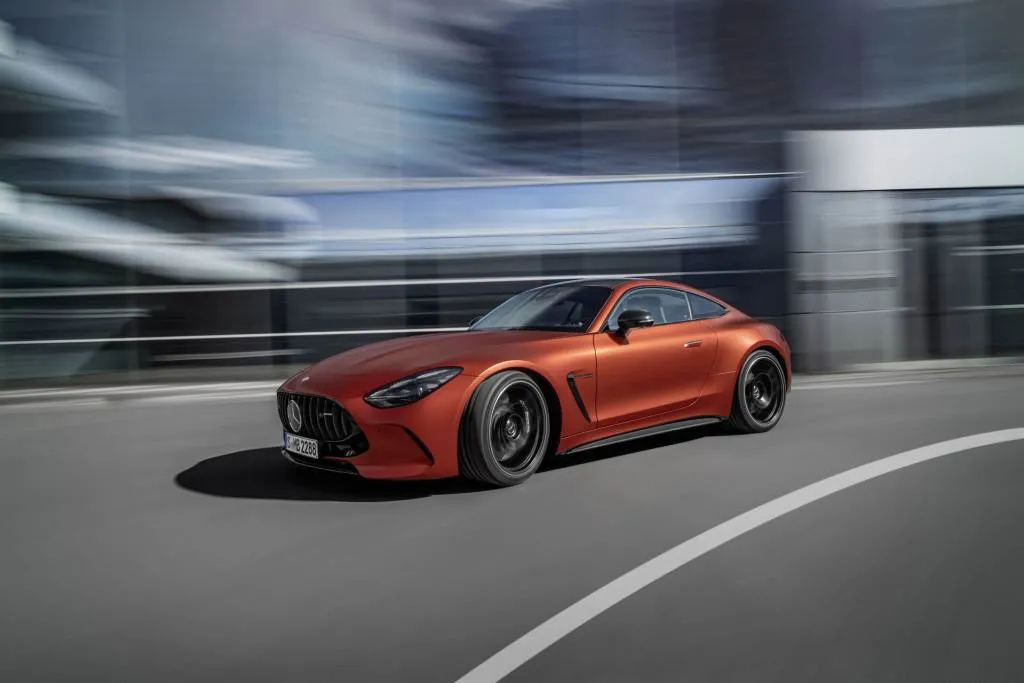
2025 Mercedes-Benz AMG GT 63 S E Performance Coupe
Mercedes AMG GT 63 S E Performance: Precise but heavy
Budgetary considerations are one reason the second-generation AMG GT weighs more than the first generation. This time around Mercedes has combined the SL and GT lineups on a common platform, with the GT serving as the coupe and the SL as the convertible. It keeps both cars in the lineup, which we applaud, and it makes the SL sportier while adding weight to both.
The second-generation GT evolves from a two-seater with a rear transaxle to a longer 2+2 with the transmission moved to the front. With its bigger body, plentiful luxury features, and plug-in hybrid system, the 2025 Mercedes AMG GT 63 S E Performance weighs in somewhere north of 4,600 pounds (official figures have not yet been published). So much weight isn’t ideal for best handling, but Mercedes employs a lot of performance equipment and advanced suspension technology, along with keen suspension tuning, to make it agile.
It starts with a hydraulic-linked suspension, a la the McLaren 750S, to counteract body roll instead of anti-roll bars. The hydraulic links and the pressure in the system’s pump determine the virtual spring stiffness. Corner hard, and the system stiffens up to prevent lean and maintain proper camber for quick turn-in response. Drive straight over a bumpy road, and the system can remain mostly open to soak up bumps. The adaptive dampers also have two hydraulic connections, one for rebound and one for compression, so they can follow along with the spring rates. The stiffness is all adjustable through Comfort, Sport, and Sport+ modes.
Even in Sport+, the ride doesn’t beat me up on Germany’s smooth, well-built roads. Throughout my time in the car, I never reach for Comfort mode due to ride quality, though I’d have to try it on America’s finest pockmarks to render a complete opinion.
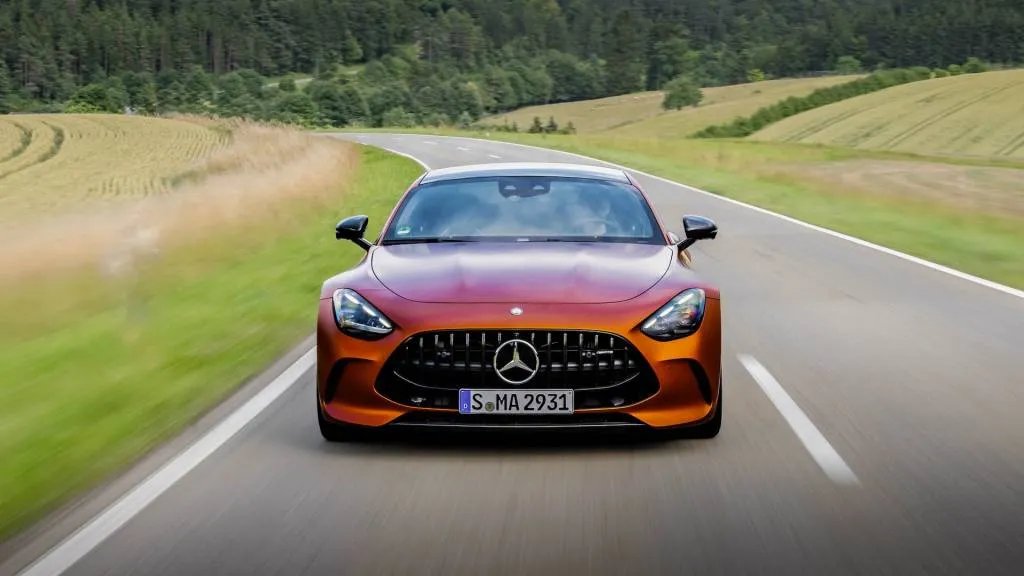
2025 Mercedes-Benz AMG GT 63 S E Performance
The rear axle is home to an electronic limited-slip differential that ensures the rear wheels apportion the power to most efficiently exit a corner at speed. Rear-wheel steering also aids parking lot maneuverability, and either makes the car turn a little sharper in lower-speed corners or holds it steadier in high-speed lane changes or fast cornering. The system can turn the rear tires 2.5 degrees opposite of the fronts, and it switches over to steering with the fronts at 62 mph. It also includes a variable front steering ratio that is quicker at lower speeds.
Active aerodynamics play a part in handling performance, too. An aero element on the underbody in front of the engine lowers 1.6 inches at 50 mph to create a venturi effect that sucks the car to the road and reduces axle lift. The car also has a retractable rear spoiler that activates into one of five positions starting at 50 mph to increase stability or reduce drag, depending on the drive program. An optional AMG Aerodynamics Package comes with a fixed rear wing that adds 31 pounds of downforce at 155 mph.
On the tighter bits of Mercedes’ route, I learn that all this equipment harnesses the GT’s weight quite well, helping the car maintain a mostly flat attitude both under heavy braking and when attacking a turn. The car turns in quickly with the brand’s typical fast, direct steering through a chunky wheel. It rotates willingly, thanks in part to a near-perfect 51:49 front-to-rear weight balance aided by all that extra weight on the rear axle. It sticks stubbornly to the pavement, too, as it rides on a big set of Michelin Pilot Sport S5 tires, 295/35R20 up front and 305/35R20 at the rear.
Braking is also robust due to a standard set of carbon-ceramic brakes that reduces unsprung weight and increases braking performance. These are the biggest beasties Mercedes has ever put on a car, with 16.5-inch front rotors and 6-piston calipers and 15-inch rear rotors with single-piston calipers.
While the suspension affords excellent control on public roads, the weight will cause some problems on a track. It will make the car understeer in sharp corners, and it will put greater stress on those big brakes. It won’t feel quite so willing to change directions, either, and it won’t feel as light on its feet as the last GT, which carried up to 1,100 fewer pounds on its well-balanced chassis.
The handling champion of the GT lineup will be the newly announced AMG GT 63 Pro. It does away with the plug-in hybrid system and its V-8 makes the same 603 hp as in the plug-in hybrid model, both of which are 26 hp more than the standard AMG GT 63 model. It comes with the Aero package and is offered with even stickier Michelin Pilot Sport Cup 2 tires. While I have not yet driven it, this drive program does include a ride-along in the Pro with legendary Mercedes racer five-time DTM champion Bernd Schneider at the wheel. In his eminently skilled hands, the AMG GT Pro appears to have all the capability of the best of the last generation AMG GT, perhaps even the track-focused GT R. Making that determination will have to wait for a drive opportunity or concrete evidence in track time.
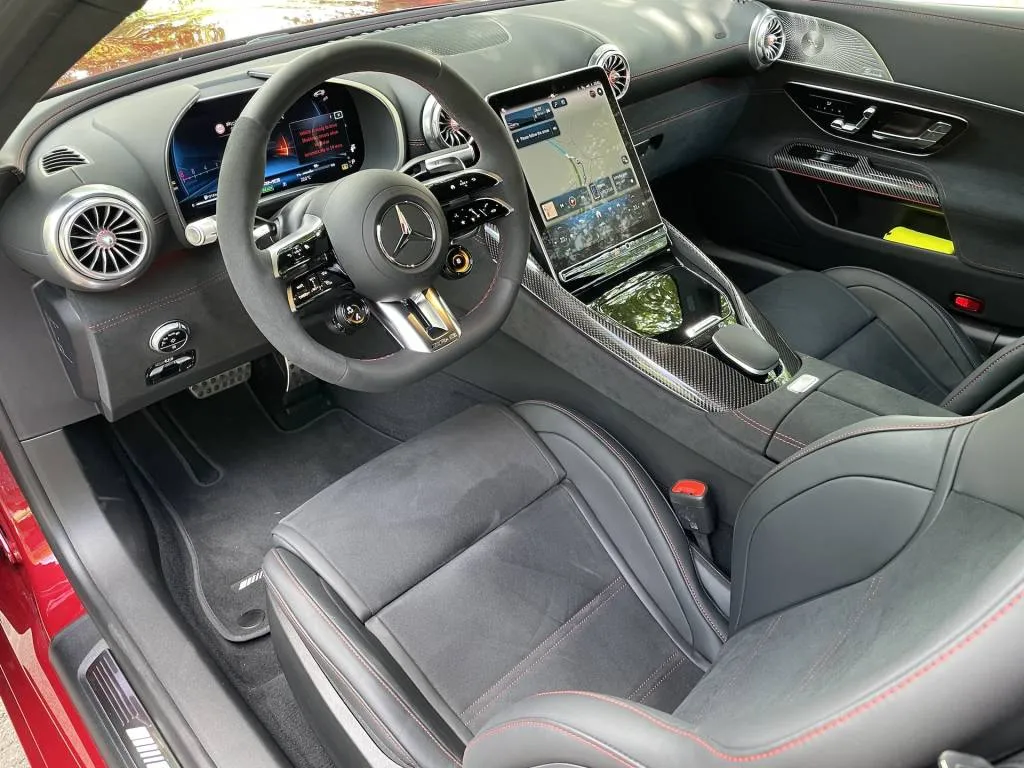
2025 Mercedes-Benz AMG GT 63 S E Performance
Mercedes AMG GT 63 S E Performance: A sporty, luxury bathtub
A low-set seating position enhances the sporty feel of any AMG GT. It’s like sitting in a bathtub, provided you’re used to a leather- and carbon-fiber-lined tub replete with screens and etched-metal Burmester speaker grilles. Its multi-contour sport seats give me the right kind of hug without squeezing the admittedly excess stuffing out of me.
The 11.9-inch center touchscreen lets me monitor several hybrid- and AMG-specific vehicle systems. The AMG Performance display shows front and rear steering angle, real-time power from the engine and motor, acceleration and brake percentages, damper forces, energy flow, and temperature of the electric drive unit, among other information.
That tech is balanced by plenty of luxuries, too, including available seat heating and cooling, two-tone nappa leather upholstery with diamond quilting and synthetic suede inserts, and optional tighter AMG Performance seats. A Manufaktur option extends the nappa leather to the armrests, door center panels, center console, and lower dash. Deep pile floormats and illuminated side sills add even more luxury. Luxury tub indeed.
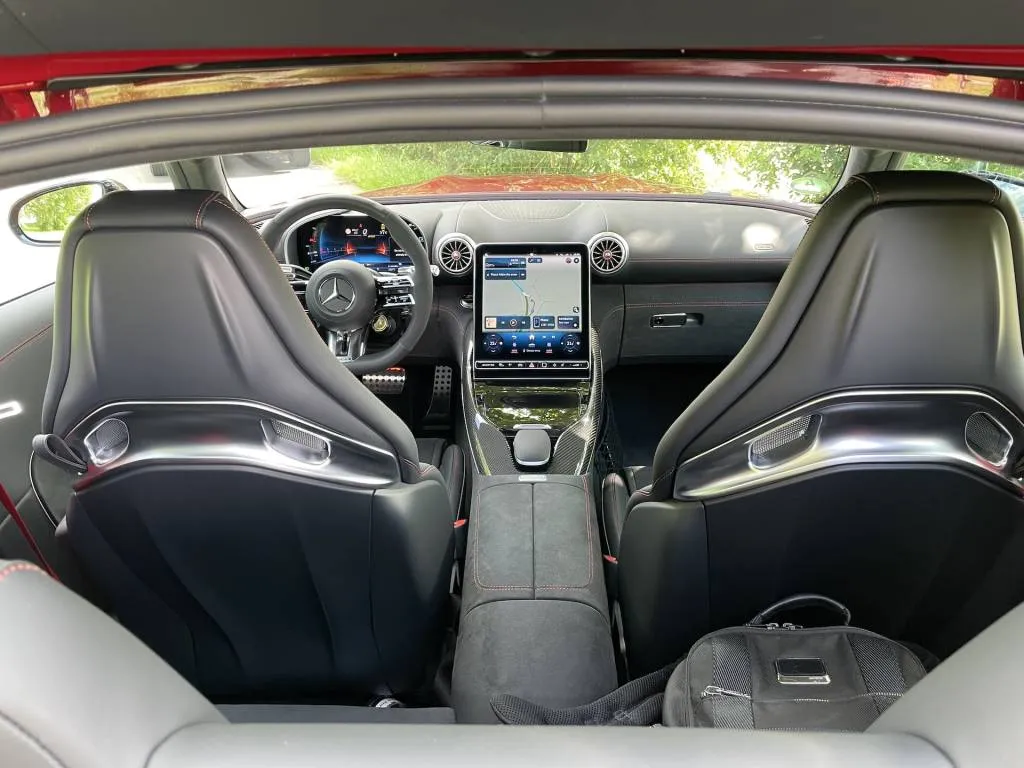
2025 Mercedes-Benz AMG GT 63 S E Performance
The AMG GT’s rear seat is about as useful as it is in the Porsche 911. In other words, it’s not fit for man nor beast, but it is a good place for my backpack. Though we call it a coupe, the AMG GT is actually a hatchback with a decently sized rear cargo area that loses a few cubic feet of space due to the battery mounted above the rear axle.
The 2025 Mercedes-Benz AMG GT 63 S E Performance is due in the U.S. this fall. Pricing has yet to be announced, but expect it to cost roughly $25,000 more than the GT 63 model, based on estimates from S-Class prices. For that money, you’ll have a decision to make. Do you want to spend more for the quickest Mercedes ever, one with incredible power and a short electric range for city jaunts, or does a purer sports car—albeit one with less power—appeal more? I lean toward the purer choice, though I doubt it could crack my back as well as the AMG GT 63 S E Performance plug-in hybrid.
Mercedes-Benz paid for travel and lodging for Motor Authority to bring you this firsthand report.

How To Calculate The Pmi For An Fha Loan 다바오 시티
buy ivermectin 12 mg for humans – stromectol 6mg online tegretol 400mg generic
buy accutane 20mg online – buy dexamethasone 0,5 mg zyvox over the counter
buy generic amoxicillin – amoxil for sale online combivent order
purchase azithromycin generic – buy nebivolol 20mg without prescription buy nebivolol without prescription
cheap prednisolone pills – buy prednisolone 10mg for sale prometrium 100mg brand
augmentin 375mg tablet – buy clavulanate tablets buy cymbalta without a prescription
generic cialis india – tadalafil ca sildenafil 50mg tablet
buy prilosec 10mg pills – oral lopressor 100mg order atenolol pills
desloratadine uk – order claritin generic dapoxetine 90mg drug
order misoprostol without prescription – how to buy misoprostol diltiazem oral
buy zovirax – acyclovir 400mg pills crestor generic
motilium 10mg cheap – oral domperidone buy flexeril pills for sale
order inderal 20mg pills – propranolol for sale methotrexate online buy
coumadin for sale – cozaar 50mg without prescription hyzaar pill
buy generic levofloxacin 250mg – buy levofloxacin 250mg generic generic ranitidine
meloxicam 7.5mg pills – celecoxib online purchase flomax generic
ondansetron tablet – ondansetron where to buy oral zocor 20mg
valtrex 500mg oral – diflucan 100mg price order diflucan generic